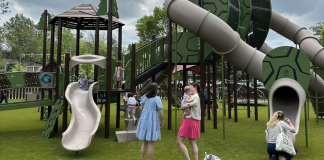
Recently, while researching children’s books to honor MLK Day and Black History Month, I stumbled upon “Let The Children March”. This book unexpectedly taught me something new about our own city. I’m sad to say I was only vaguely familiar with the children’s crusade in Birmingham. What I’ve since learned inspires, angers, and challenges me.
Entire books detail these events, and what I’m offering here is a very abbreviated version, but I hope you find this adult history lesson impactful.
The Year is 1963.
Jim Crow laws run rampant in Alabama, keeping white and black citizens separated, not equal. These laws are particularly bad in Birmingham, leading Dr. Martin Luther King Jr. to call our city “the most segregated city in America.” Around 50 bombings of black churches and homes occur between 1947 and 1965, giving our city the name “Bombingham”.
Rev. Fred Shuttlesworth, a major figure in the civil rights movement in Birmingham, invites Dr. King to visit the city that spring. He hopes his presence will increase involvement in the marches. Rev. Shuttlesworth tells Dr. King “If you win Birmingham, as Birmingham goes, so goes the nation.”
They know that if enough people peacefully march, enough will be arrested to fill the jails. This will create the stir to make change a reality.
Protests begin in early April. Dr. King himself is arrested and held in jail for a week. The passive reaction from local clergy prompts him to write the monumental “Letter from a Birmingham Jail” at this time.
But even Dr. King struggles to bring in enough participation. Families needing to pay bills and put food on the table understandably fear the threat of jail time or job loss. Possible retribution, an active Klu Klux Klan, and the scare tactics of public safety commissioner Bull Connor certainly play a role in low turnout.
While many march and are arrested, Birmingham isn’t gathering enough steam to really push the movement ahead.
Then activist James Bevel presents an idea.
Invite the young people to march.
Many people oppose this idea, understandably. I can’t imagine the fear of sending my child into a protest, knowing the threats that may come his way.
But the black children of Birmingham know if they don’t march now, they will be marching for the same rights as adults. Not marching for change will cost them far too much.
After much debate, leaders agree to train young people in their principles of non-violence, and plan May 2nd, 1963, as the first children’s march.
Word spreads fast among students in school (no social media needed, apparently). At noon, students leave class to head downtown, despite attempts by the schools to stop them.
Countless children, ranging from ages six to 18, miss school to meet at the 16th Street Baptist Church. Hundreds leave in organized waves, heading to Kelly Ingram park, armed only with signs and songs. When confronted by police, they kneel to pray and are promptly arrested. But more waves of children keep coming!
By the end of the first day, police arrest over 500 children.
This is just the beginning.
Bull Connor knows if children continue marching, he will run out of room to hold them. So he decides he needs a deterrent instead. The next day, May 3rd, demonstrators are not met with simply being taken to jail.
Children are knocked off their feet by water hoses meant for putting out fires. They’re sprayed while huddled on the ground and hiding in corners.
Children are senselessly attacked by police dogs and batons.
People around the world soon come to see these infuriating images from Birmingham.
The children’s marches continue that week, with crowds continuing to grow and jails filling to the brim. Authorities hold young people at the local fairgrounds for several days, as there are no beds remaining.
On May 6th, large numbers of adults join the demonstrations, inspired by the children. This leads to a day of massive arrests. By the end, thousands of children are in custody.
Dr. King addresses the community at a rally that night, saying “you will make it possible for the historians of the future to write a marvelous chapter.”
As demonstrations continue, Gov. George Wallace becomes more involved by sending officers and weaponry. The show of force increases violent altercations between protestors and police. Shuttlesworth is hospitalized after being shot with water hoses while trying to maintain the peace.
Economic disruption intensifies, which finally motivates negotiations.
Over the following days, peace talks occur between city business leaders and civil rights leaders with the Southern Christian Leadership Conference (SCLC). On May 11th, they reach an agreement and outline how desegregation will begin in the city.
Change does not come fast, unfortunately.
In fact, much violence still occurs in coming days and months. On May 12th, the Klan sets off multiple bombs, which sparks riots rather than peaceful protests. Sixteenth Street Baptist is bombed four months later, killing four little girls. President Kennedy is assassinated that November.
But amidst the violence, progress slowly occurs. The people do not re-elect Bull Conner. Birmingham begins to see spaces desegregated. The courts block the school board from expelling all students who marched. Dr. King leads the historic march on Washington. And that summer, legislators create what will eventually become the Civil Rights Act of 1964.
And the children of Birmingham ignite a spark of peaceful protests held by young people all around the country.
Its 2022.
I’d like to believe I would have been willing to march in the sixties for equal rights. Sadly, I doubt I would have been so brave.
I have no doubt, however, that letting my child march without me would have been terrifying. I feel certain the parents of the thousands of children who marched in 1963 felt the same. All of Dr. King’s reassurance that they were fighting for the good of all mankind wouldn’t take away a mother’s fear.
How bad must it be to let your child march straight into jail?
In recent years, we have watched more protests occur, continuing the demand for equal rights and protection. We have seen countless young, peaceful protestors taken to jail. It feels impossible to not parallel the images from 1963 with many from present-day.
Much has changed. And more change is still to come.
What will it take for our children to live in the world Dr. King dreamed of? And what will we be willing to sacrifice to make it happen?
References for more information:
Website- History Stories: The Children’s Crusade












This article absolutely blew me away. This is journalism at it’s finest- THANK you for putting so much time and effort into this piece. I NEEDED to learn this.
Chelsey thank you so much for reading and commenting!!
Comments are closed.